It’s Wednesday – a good day for a game!
I am the happy new owner of a collection of exquisitely fine, detailed embroideries that I’m going to tell you more about later on, as I finish up some research on them and clean them up.
I’ve been on a quest – thanks to the prodding of a reader in Australia who was on a similar quest – to find samples of this embroidery, and finally, I’ve got some in my grimy paws.
As you look at the photos below, can you guess what fabric this embroidery is worked on?
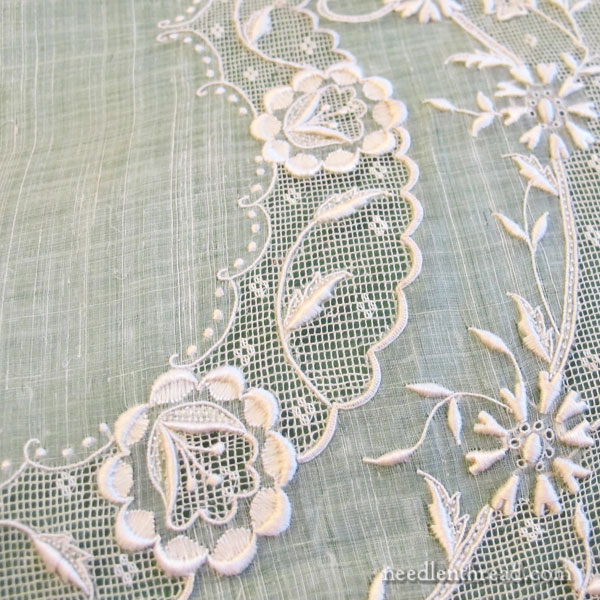
Pretty, isn’t it? The embroidery is done in very fine cotton threads, in ecru. The piece itself is not white – it’s more off-white or ecru, and it is somewhat discolored with age and storage stains and whatnot.
I’m going to wash it later this week – I can’t wait!
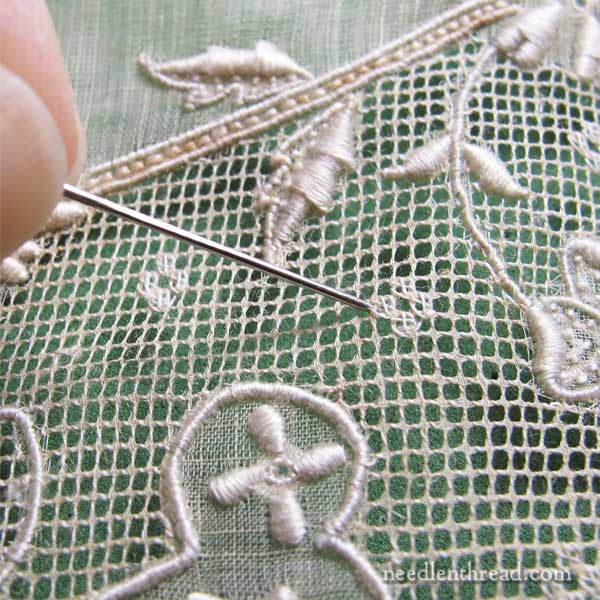
The problem with taking photos up close is that it’s not always the best perspective, for appreciating the delicacy and fineness of the work.
In the photo above, I’m using a #28 petit tapestry needle (a tiny needle!) to point to an interlaced drawn thread element.
It is almost beyond fathoming, how fine and detailed this embroidery is.
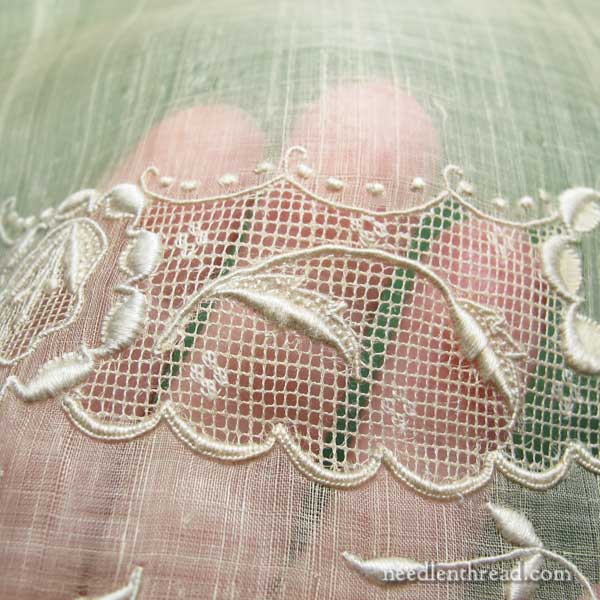
The fabric, as you can see, is sheer. That’s my hand back there.
The piece is somewhat soft and supple, and airy light. There’s practically no weight to it!
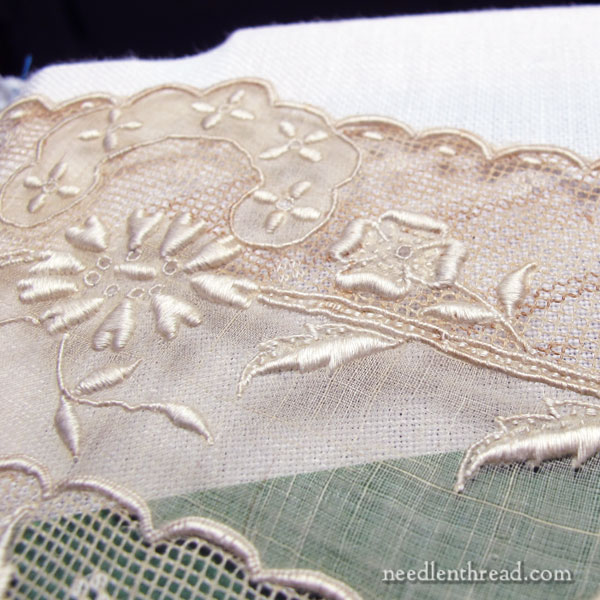
This end of the cloth is the most color damaged – you can see the streaks of discoloration in it, on the right side of the photo.
But, over a white background, you get a better sense that the cloth was not white, even originally.
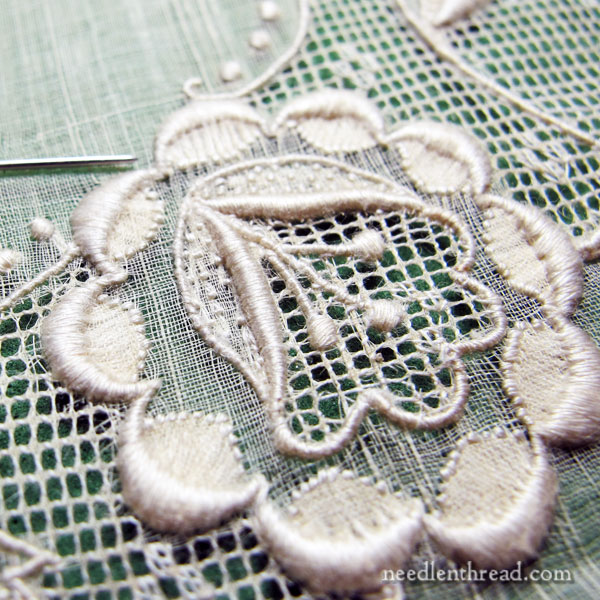
And here’s one of the flower elements up close, with the tip of the petit tapestry needle showing up on the left side of the photo.
The element is made up of satin stitch, a little bit of trailing, some drawn thread, seed stitch, and this:
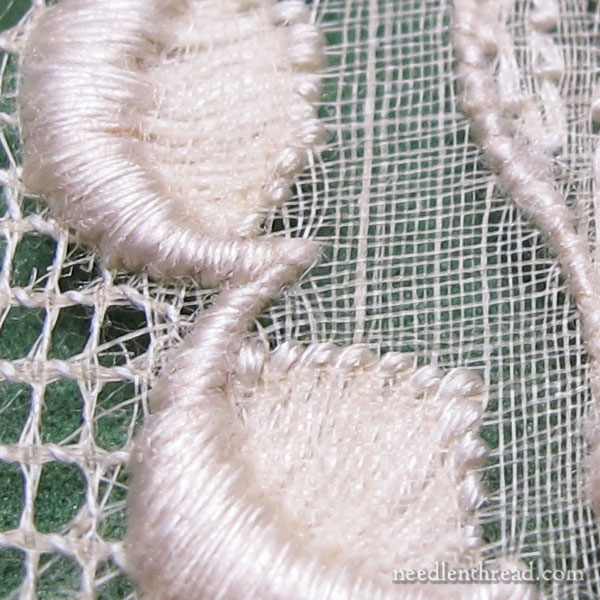
Can you see what’s going on there? (You can click on the photo for a larger version.)
The stitches on the inside of the padded scallops travel up the inside scallop on the back of the fabric, they come up from the back of the fabric, and loops over a tiny bit of the front of the fabric to add that little perfect tip on each stitch.
Oh, gosh, I love that! You can only do that kind of thing with a very sheer fabric (or netting) and get such a nice, finished affect from it.
You can also see the fabric quite well in the photo above. It’s somewhat irregular, with an open weave.
So, my question: can you guess what type of exquisitely fine fabric this exquisitely fine embroidery is worked on?
Chime in below with your guess! Or even if you know for certain (I’m sure many of you will know – you’ve probably run into this in your world travels…)
I’ll show you this whole piece and others in the collection after I’ve cleaned them up a bit, so that you can see them in their full glory. And at that time, I’ll tell you a bit about their history.







As the threads are uneven, they may be linen. I do not know the words in English, but in French we would call this kind of fabric either “batiste” or “linon” for the finer one.
Is the piece worked on illusion?
It is extremely detailed. So pretty, and very, very, impressive. I hope the set cleans up well. Can’t wait for your little history lesson 😉
Sarah
Beautiful work! Thanks for showing it to us, Mary. It looks like gauze to me.
Oh my goodness Mary,
I’m leaving drool marks on my keyboard(that may freeze given the weather here in Quebec). Is the fabric cotton lawn?
Thanks for the peek at your new collection. Can’t wait to see more!
Mary D.
That was my guess as well – looking forward to further details.
Beautiful!
I’m wanting to say the ground fabric is individual un-spun silk fibers woven into gauze? I’m not really seeing any twist like multiple fibers spun together. I have no clue what the official name of such a fabric would be though.
I do like a guessing game! I think this may well be Pina (pineapple fibre) lace from the Philippines.
Yep, it is, Sue.
Mary,
That was my first guess, too. I lived in the P.I. for a year and have a couple of samples of it made up into shirts and hankies. As a gift, we received a couple of yards of the fabric which I have never taken out of the box because I was not sure how I wanted to use it. As an embroidery background I can use it to make something to display. I also have some fabric made out of banana fiber which is similar, not quite as fine, but also beautiful.
Is it muslin? It’s fine, even for muslin but I can’t think of a lighter fabric.
Can’t wait to find out!
Is this a very, very fine linen batiste?
Its a beautiful piece of work! No sure what the base fabric is, but it looks like Muslin.
It looks like Madiera embroidery on organza.
Years ago a friend and her mother traveled to Madiera before the demise of the industry to visit the factories and some of the cottages where the stitching was being done.
It sure is a beautiful technique.
How beautiful! It looks like linen to me, but I’m guessing that’s too easy an answer. Can’t wait to learn more.
Is it worked on cheesecloth?
Linen…
Batiste?
If not muslin it must be a very fine lawn cotton….
Dear Mary
I’m guessing the fabric is silk or cotton Tulle or fine netting the embroidery is very detailed and beautiful, is it from a particular European country where they embroider on this type of fabric? I can’t wait for you to reveal the whole story on this collection and what the piece is used for, it’s a mystery. Thanks for sharing this beautiful piece and I’m looking forward to the photos of the rest of the collection.
Regards Anita Simmance
I’m guessing that the fabric is fine cotton lawn. It is beautiful fabric and the embroidery is spectacular! I love it!
I haven’t read any comments yet… it reminds me of a very fine version of horsehair interfacing used in structured tailored garments. So I am guessing some kind of animal hair.
Wow what a delicate fabric,looks like duping silk with a blend of linen, gosh that is a real precious piece, Just love it,
Diane,
It should have read dupiony silk
My guess is silk…but I honestly don’t know. I do know that it is stunning!
It looks like Philippine pineapple silk, very sheer but also crisp, made from pineapple leaves!
Very good, Laura! 🙂
My guess for the fabric is batiste or air.
This looks like a variety of organdy to me.
No, I think it’s batiste.
Is it lawn?
How do you wash such fine, delicate work?
Very Carefully! 🙂 Actually, this particular fabric has very specific washing instructions, because of its composition. No one has guessed it yet! I’ll talk about the washing and so forth later on….
I would call that fabric Lawn.
Until I saw the sheerness, I thought swiss batiste or handkerchief linen.
Now I’m thinking silk gausse (sp?).
My guess is a very fine linen. A for the whiteness, It is probably a “natural color”. which is an off white, and age/circumstances have left the stains.
Thank you so much for sharing this beautiful whitework embroidery.
Linen. I have the remains of a table cloth from a plantation in the 1860’s or so and it looks the same. Mine is not embroidered, however.
My guess is nuns’ veiling.
Hi Mary,
Love the embroidery piece – it is lovely. I have some old pieces like this and hope you will discuss how to wash these properly!
Much Thanks!
Praca – piękna, mój ulubiony rodzaj haftu. Myślę, że to jedwabna gaza.
Pozdrawiam
Anna
I have some lovely hand embroidered napkins on RICE LINEN, but this may be even finer? Anxious to see more!
Filet guipure?
Mary-
Your mystery fabric is more than likely a fine linen. I do a lot of very fine embroidery and am always searching for fine quality fabrics. I do own some yardage of antique linen that is just as fine as the item you have pictured. As I am sure you know, we can no longer get the quality of the long staple cottons/flax that were available years ago to make such fine fabric. The finest linens today are much more coarse!
Thanks for sharing this sample with us!
-Phyllis
Voile?
You are one lucky lady to have acquired such exquisite embroideries. I’m thinking the base fabric is white cotton muslin. Are your embroideries an example of Chikan work by any chance?
I own a piece of this embroidery, it came from England and was probably stitched around the turn of the century.
I have always thought that this piece of fabric was called linen scrim but in Therese D Dillmont Encycolpedia of Needlework under embroidery on white materials it looks like it could be cambric.
Perhaps the fine fabric is Swiss batiste. I’ve used this fabric in making baby gowns with smocking, and your description made me think of this.
I am not sure what it is but it IS Beautiful! I will stand by until you reveal to us what it is.
Truly amazing!This kind of work takes a lot of patience and know how! It is exquisite. I believe the fabric is a handkerchief batiste? Thank you for showing us. It is not every day that one can see such fine work.
I would guess it’s a fine batiste. Some thing they used for ladies under ware a long time ago.
Is it linen?
I do not know what kind of fabric it is since I am fairly new to Embroidery.
But I will like to know how you intend to wash such a delicate fabric.
Thanks for all your articles; they are so very informative.
Hi Mary, warmest greetings from the Philippines! I am not too sure, but looking at the photos, the fabric looks like a pina or jusi cloth and the embroidery style is quite common in Batangas, a province south of Manila, which is the capital of the Philippines. In fact there is one town there devoted solely for this kind of embroidery, although there are other types as well.
Yes, it is piña cloth!
beautiful beyond words, I am guessing
hankerchief linen
Wow! beautiful fine work. I am guessing the fabric is either silk gauze or a pineapple fibre from the Phillipines. Hope you are able to get the stains out. Thank you for sharing this with us.
Yes, it’s piña cloth!
Irish. Not really a clue but exquisite!!
Hi Mary,
I think this is a pineapple fibre fabric from the Phillipines?????
‘Tis just that!
Is it pineapple cloth?
Why get the “stains” out? It is lovely as it is.
Imperfectly perfect!
it looks like what my mother would have called “lawn”
Hi Mary. Is the fabric lawn or muslin?
The fabric looks to be linen.
I have never heard of pineapple cloth before. I’m looking forward to learning how to clean – and identify – it!
I can’t guess what the fabric is, but have a question about the Hungarian szur. My brother has a Hungarian pumi dog and wants a costume for when they go to dog shows. He suggested a web site on Yahoo that has a pattern for the cloak. I also explored other sites and found many, many variations of the cloak. Some with embroidery; some without. Of course, you and your Hungarian table runner came to mind. The embroidery for the szur, however, looks more complicated, using various motifs in multiple colors.
Any guidance you can give me will be most appreciated. I do cross stitch now, but did embroidery as a teenager – which was at least 100 years ago. LOL Since my brother asked if I was up to this, I don’t want to disappoint him. Big brothers so seldom ask little sisters for anything.
Thank you so very much, Mary
I thinks it’s lawn.
I’m guessing butter muslin.
What kind of garment warranted such exquisite work on such delicate fabric?
I would say it is a very fine linen. Earlier in life I would have said a cotton batiste, but a number of years ago I inherited some linen so fine it rivaled any cotton batiste I had ever seen.
I’m going to guess it’s a batiste.
muslin
Handkerchief linen
It looks like it is pineapple fabric from the Phillipines. It is an off white with an almost transparent look. I have pieces that have the most wonderful pulled thread and satin stitches on them.
My guess would be grass linen as I have cloths made of this and they are similar with this lovely fine look about it – maybe??
Thanks
Eleanor
Isle of Man
Is it batiste?
I submitted a comment before but it did not show up so if you have two forgive me. It is pineapple fabric from the Pillipines. I have a couple of pieces and they feature the most wonderful pulled thread and padded satin stitches.
It looks like it has a slight sheen to it. I’m going to guess organza.
I think it looks like pina fabric, from pineapple fibers. I’d love to see some of that work in person! It looks exquisite.
Mary,
Thank you for displaying this. I don’t know what it is, but I am very curious about it and it’s thread count.
I’m guessing either linen or silk…
It is batista.
Banana Silk!!!!!!
meant pineapple…..was writing banana on grocery list….geez….
Well Mary,
Since I have already read all of the comments and know that this is piña cloth, I am going to take the guess one step further and say that this is a handkerchief. I have some handkerchiefs in my possession similar to this one that I would never let come near to my nose! The amount of time spent on the handwork that went into them is mind boggling. There is a free Kindle book called the Autobiography of a Handkerchief written in I believe the 1700’s which I find quite amusing should you ever care to read it. It goes into the making of an exquisite handkerchief.
I think it is a pineapple fiber That is used in the Philapenes
Is it pineapple silk?
Batiste? Whatever it is, it is gorgeous!
Resembles cheesecloth.
Pineapple fiber
Silk gauze? I’m anxious to hear your technique for cleaning and restoration.
Beautiful can’t wait to see it cleaned up
Is the fabric cotton “Lawn”?
I’m thinking it may be just plain, multi-purpose gauze, but is it even possible to embroider in gauze? I’m stumped and truly curious to find out what this fabric is….
So beautiful, almost ethereal. Perhaps a fine linen lawn.
I think it is either linen or cotton batiste.
Iam going to say linen?
Hi Mary, How exquisite! My guess is linen.
It reminds me of Lady Evelyn’s work, although I think a lot of hers was on cotton batiste.
I’m excited about this post and looking forward to more pix and info!
Thanks!
My guess is pina cloth, made from the fibres of pineapple leaves. Gossamer thin, but for its thickness, very strong.
this is Linen
Pineapple cloth from – it’s usually the Phillipines? Anyway, that’s my first guess – next is ultra-fine linen and then, silk…but my main guess if pineapple. It’s the open weave, the sheerness, the color, the uneven, yet crisp and almost ‘woody’ appearance of the individual threads that are leading me to this guess.Yep, if I had to make only one choice it would be pineapple fiber in a tabby weave.
Is the fabric swiss batiste or linen? It is beyond beautiful, it’s breathtaking!
It looks very much like a light cotton batiste. Whatever fabric, it’s very intricate and gorgeous stitching. Love it!
Cotton voile?
Pina cloth. This website never ceases to amaze me. Thank you Mary!
I think it is a fabric that in my native England we used to call lawn, it was used to make baby clothes I think.
Is this gossamer lace? Although that might just be a description, not the actual stitching technique. I believe that the fabric is linen or voile. Such intricate work! You are correct in that it almost boggles the mind.
Cheesecloth? K
Looks like what I remember called Lawn. It is pronounced that where I come from, but not certain it that is how is spelled.
Pineapple cloth.
I think it is a very, very fine linen batiste and the hand embroidery is Ayrshire embroidery. Exquisite!
Hello Mary,
it is very fine linen – such embroidery used to be done on linen.
Jakica
Is it pina embroidery from the Philippines?
Dear Mary, what a great teaser. It is difficult when you cannot actually see the fabric, but my guess is it is what my mother would call Swiss Lorne, I’m not sure how to spell “lorne”, lawn, laun, and is a very fine linen. Cant wait to see what it really is.
Helen.
coton lawn fabric
I found this website. It gives an explanation of the fiber and a short video how the fabric is made. Quite interesting!
Dear Mary, what a great teaser. It is difficult when you cannot actually see the fabric, but my guess is it is what my mother would call Swiss Lawn.
To me the fabric looks like a very fine mosquito netting – each fiber looks very strong for its size – cotton lawn is fine…however, this appears even finer than lawn – my great-grandmother had summer slips and hankies so see-thru like this … however, I do not have samples to compare. Extraordinarily lovely…can’t wait to find out the type of thread.
Thank you, Charlotte
Is it organdy?
Hi Mary,
I too have read all the comments so know it is piña cloth. It is truly georgous and I’m amazed at the minute embroidery of the interlaced drawn thread element you pointed out. Like others I too wish to know how to wash and iron such a sheer fabric and of course what needles and thread to use when embroidering it. One last question – where did you get it?
How beautiful! I love delicate work like this, and am in awe of the people who have the patience and tenacity to do it.
I think it’s a muslin of some sort – but really don’t know.
I read through some of the replies, and became intrigued with pina cloth, having never heard of it (haven’t been to the Phillipines). I have googled it, and am amazed by it! I thought when I saw Mary’s pictures that it had a stiffness that muslin doesn’t have – and now I know why.
What beautiful fabric. I’d love to have something in it, too!
Is it muslin? Jane Austen-style muslin? I can’t wait to see if this is a dress!
Is it cotton muslin or linen lawn? If it’s European, my guess is linen lawn.
Is it possible this is a very very very fine hemp? the hairy fibers in the last pic look like it is stringy a plant-based fiber
I love your website and all the examples and discussion you provide! Thank you so much for sharing.
This looks like a very fine linen fiber, but my second guess would be a silk gauze.
My guess is that it is Sea Grass linen.
A very fine silk..
Crinoline? Horsehair?
It’s obviously a cellulosic (plant) fibre, but it’s low twist with s no sign of fibre ends sticking out so it’s not cotton. My first guess was a very fine linen, but it if was linen you wouldn’t be asking us to guess. So my next guesses would be ramie or abaca (pineapple fibre)- which I see others have already guessed under the name piña, which you have confirmed. It’s a really lovely piece and I’m glad it has found a good home with you.
I think it is a very fine lawn or gauze with some needle lace worked.
A very fine even weave cotton? circa 1898?
Lawn?
Batiste?
It is locally called piña in my country (Philippines) and quite expensive. This cloth is used mainly for our men’s formal wear called the Barong Tagalog. Other items such as veils, doilies, and table cloths are made with this fine cloth too. This is a very delicate fabric that needs hand washing only.
HI Mary,
My guess would be silk organza. Thanks for sharing such a lovely piece.
Pina cloth from the Philippines
Is it the type of fabric called lawn? All I know about lawn is that it was sheer, very sheer, and frequently had embroidery on it.
I can tell that the fabric inside the last flower is the actual fabric, and the “hatching” is made of wrapping 3-4 strands of the horizontal fabric strands together. The same seems to be done with the vertical threads, but I can’t see the sewing thread around the vertical cloth threads like I can on the vertical ones. At first, I thought the “hatching” was the original fabric, and it is almost netting in appearance.
It looks as if it could be Pina fabric.
Oops. I’d thought abaca was pineapple fibre but after I commented I googled – abaca is banana. Mary, I’ve learned even more from your wonderful blog than you may have thought!
One look and I knew what it was.. pineapple fabric, or piña fabric. from the Philippines. it was the little spiky threads that gave it away.
It’s a very delicate fabric and as you said, there are special cleaning instructions for its care.
It is an expensive fabric.
Lovely. just lovely.
Oh Mary I am drooling,I had a similar cloth so fine and fairy like that I used at my daughters wedding for the wedding cake table.Unfortunately gone in the bush fire along with all the rest of my antique tablecloth collection. Still I am so glad that I actually used my things Good memories.I was told by a very knowledgeable (?spelling)embroiderer that it was pineapple cloth from the Phillipines.Love your blog look for it every day.Best wishes for 2015 Chris
Oh, it’s so beautiful. It looks quite like Ayrshire whitework. That would be mostly Christening gowns, the Ayrshire. It is my very favourite. Not just because of the embroidery, but also because of the elements of the gown, the pieces and how they are put together, are customs related to so many ancient beliefs (or some would say superstitions). I will love to see your new collection revealed, though I think it is not Ayrshire whitework.
Hi Mary,
What an exquisite piece of embroidery. I think it might be done on ‘toile d’ananas’ . Ananas is pineapple, as you know. Is that it?
Hi.
I don’t know what cloth it is but it reminds me of cloth used for bandages.
The weave is reasonable open and irregular thread thickness, but the embroidery suggests even weave. There is a crispness to the fabric. I think it is a fine muslin, which were made of cotton. Muslin was also called muslin gauze and came in various weaves from very open to tight.
It’s an exquisite example of embroiderer’s skill.
This is stitched on a fine cotton organdy. Probably done in Vietnam.
I would say it could be cheese muslin. When I was young milk which had gone off and had separated would be poured through the muslin. The muslin would then be gathered up to contain the milk curd, and tied before being left to hang to make cream cheese.
My guess is Handkerchief Linen.
During the war my great aunts used bleached flour bags and similar to crochet and embroider. One was used as an alter cloth by a world war 2 re-enactment group
I wonder could this be something similar?
A beautiful piece of work
My guess is, it could be fiber made from pineapple, or what is called in the Philippines “Pina fabric”
My guess is the fabric is a fine cotton lawn.
Dolores in Michigan
real fine batiste
This looks similar to the 40 count linen I was working on in a class workshop last year, but it is much finer, so I’m guessing maybe 50 count linen
I don’t know, my first guess would be flax. Maybe silk.Can it be anything with bamboo. Ok that’s really out there and I am ignorant, LOL.
LOL! Not as far out as what it really is – which is pineapple cloth, made from the fronds of pineapple plants!
y guess is very fine linen (voile) because of the irregular weave and the ‘hairy’ threads in the close up.
Blessings
Maxine
Just gorgeous, Mary.\French batiste or cotton lawn?
OK so most of the guesses were wrong as was my first – handkerchief linen, but my second was on track not that I knew the name of the fabric, just that it was made from pineapple fibres.
What is the item itself though? It looks absolutely exquisite but I am feeling quite anxious to know what it actually is.
100% linen????
It looks like Pina cloth made from pineapple in the Phillipines.
I am not sure of the fabric however I once found some antique Victorian sewing needles that are minisclule and probably small enough to do the job but the work involved is amazing and I rather suspect they did not have magnifieing lenses to work with then.
I think is something like gauze… after a visit to dictionary maybe you call it lint? Very ancient embroideries were made on gauze/lint – a cotton fabric
I miss to say this is absolutely exquisite! So beautiful.
In my vocabulary it’s called ‘Eye Candy’ – delicious.
Smart folks here who knew!!
My guess is that the work was done on pina cloth, a very fine linen-like fabric.
This exquisitely fine fabric is none other than LINEN (according to me :p)
Linen is made from flax,a vegetative fiber and it is also one of the most often used fabrics.
Hi Mary — Did you ever post a photo of this after you cleaned it? I’ve searched but come up empty. I’m very interested in the details on this piece. I once had a large bridal veil remnant with this kind of embroidery — it was truly gorgeous — and I’m always looking (but without success) for similar pieces. I don’t know what you call it, so please enlighten me.
Hi Mary,
I was struck dead in my tracks with I spotted this post on Pinterest. That work is stunning! I think what you have is a very fine linen fabric. The work looks French to me, based on the fineness of the work; nothing more, so I might be wrong. I was able to purchase some of this linen on my first trip to Madeira to study embroidery with the masters there. It was very old and it was in the “stash” at the Imperial Embroidery Factory in Madeira. It’s so ridiculously fine, I had to have it, and I still do in my “stash”. I paid over $100/yd. for it and I’m still very happy to have it, at any cost. I only wish I had purchased more. It does have a few pinholes in the weave, but I don’t care. I will be using it soon, to do this project shown. Thanks for your hard work and keep it up because you are probably not aware how much your work excites us. My best, Wendy Schoen
It’s pretty incredible, isn’t it, Wendy? I love the piña cloth – I have some as well, but I have not yet ventured into stitching on it. I’m a bit chicken on that score.
I agree this is the most beautiful fine work I have seen,as a finee embroider myself I stand in awe, if you ever find out how its embroided please put me on your list.Hilda
I don’t know the material, but I’d sure hate to make a mistake and try to rip it out! LOL
Could it be “glass batist”? A very sheer indian cotton battist that was handwoven and has pretty much died out? Or is it very fine swiss linen batist?
I love this post, the embroidery is devine!
Love, Annie
It’s piña cloth, made from the fibers of the pineapple plant.